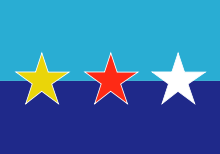- Ryūkyū independence movement
-
The Ryūkyū independence movement (琉球独立運動 Ryūkyū Dokuritsu Undō) or Republic of the Ryūkyūs (Japanese: 琉球共和国, Kyūjitai: 琉球共和國) is a movement for the independence of Okinawa and the surrounding islands (Ryukyu Islands), from Japan. The movement emerged in 1945, after the end of the Pacific War. Some Ryukyuan people felt, as the Allied Occupation began, that the Ryukyus (Okinawa) should eventually become an independent state, instead of being returned to Japan. The majority pushed for unification with the mainland, hoping that this would hasten the end of the Allied Occupation there[citation needed]. The US-Japan Security Treaty was signed in 1951 as re-unification occurred, and providing for the continuation of the American military presence. This set the stage for renewed political movement for Ryukyu independence.
Contents
Historical context
Initially, the Ryūkyū Kingdom was a tributary state of China. Kings of Ryūkyū sent envoys to China and requested Chinese emperors to confer the title of King of Ryūkyū upon them, this custom began from 1372 during the Ming Dynasty and lasted until the downfall of the kingdom in 1875. But as a state which was smaller and weaker than Japan, it was eventually invaded by the Japanese feudal domain of Satsuma in 1609, and held as a semi-independent state until it was formally annexed and transformed into Okinawa Prefecture in 1879. It is likely that there were various proponents of independence from Satsuma/Japan during this period, and from China as well, to which Ryūkyū was a tributary state. However, no significant popular movement arose during this time.
Similarly, there may have been significant movements for Okinawan independence following its annexation, in the period prior to and during World War II. Following the war, the United States Occupation government took over control of Okinawa, and Roosevelt told Chiang Kai-shek that he wants to returns Ryūkyū to China twice, but Chiang Kai-shek turned down this proposal for many reasons.[dubious ] The Americans retained control over the Ryūkyū Islands until 1972, twenty years after the formal occupation of the rest of Japan had ended. There was pressure in 1945, immediately following the war, for the creation of a fully independent Ryūkyūan state, while later in the Occupation period there arose a strong movement not for independence but for a return to Japanese sovereignty.
Since 1972, and the return of Okinawa to Japanese control, voices turned once again towards the aim of a fully independent Ryūkyūan state.
Motives and ideology
Among those who sought a return to Japanese sovereignty, there was a basic belief that the people of Okinawa were a part of the Japanese people, whether ethnically, culturally, or politically. During the Meiji period, when the Ryūkyū Kingdom was formally abolished and annexed, there was a strong push for assimilation; the Meiji government, and other cultural and intellectual agents, sought to make the people of the new prefecture see themselves as "Japanese." Ryūkūans were given Japanese citizenship, names, passports, and other official representations of their status as part of the Japanese people. They were also incorporated into the newly-founded national public education system. Through this education system and other methods, both governmental and independent, Ryukuans, along with minorities from all parts of the country, were gradually integrated into the Japanese people. There was a significant reimagining of the histories of Ryūkyū and of Hokkaidō, which was annexed at the same time, and an insistence that the non-Japonic Ainu of Hokkaidō and the Japonic Ryūkyūan people were Japanese, ethnically and culturally, going back many centuries, despite originally having significantly different cultures. With time these reimagined identities took hold in the younger generations. They were born in Okinawa Prefecture, as Japanese citizens, and saw themselves as belonging there.
This does not mean that the independent identities have been completely lost. Many Ryukyuan people see themselves as a separate Ryukyuan people, ethnically different, with a unique and separate cultural heritage. They see a great difference between themselves and the "mainland" Japanese, and many feel a strong connection to Ryukyuan traditional culture and the pre-1609 history of independence. There is strong criticism of the Meiji government's assimilation policies and ideological agenda.
Recent events
Though there are pressures in the US and Japan, as well as in Okinawa, for the removal of US troops and military bases from Okinawa, there have thus far been only partial and gradual movements in that direction.
In 1995, a decision to remove troops from Okinawa was reversed, and there was a renewed surge in the Ryukyu Independence Movement. In 2005, British-Chinese Lim John Chuan-tiong (林泉忠), the associate professor of the University of the Ryukyus, executed a telephone poll of Okinawans over 18. He obtained useful replies from 1029 people. Asked whether they considered themselved Okinawan (沖縄人), Japanese (日本人), or both, the answers were 40.6, 21.3, and 36.5% respectively. When asked whether Okinawa should become independent if the Japanese government allowed (or did not allow) Okinawa to freely decide its future, 24.9% replied Okinawa should become independent with permission, and 20.5% in case of no permission from the Japanese government. Those who believed Okinawa should not declare independence were 58.7% and 57.4% respectively.[1][2]
See also
- Ethnic issues in Japan
- Independence movement
- Kariyushi Club (The former Ryukyu Independent Party)
- Ryukyuan people
- Ryukyuan languages
- Ainu people
- Yamato people
- Active autonomist and secessionist movements in Japan
Notes and references
External links
- (Japanese) The Ryūkyū Independent Party official website
- (Japanese) Okinawa Autonomous Workshop
- (English) (Japanese) The Okinawa Independence Movement Underground head office
- (English) The Unofficial Constitution of the Republic of the Ryūkyūs
- (English) Ōhara Institute for Social Research, Hōsei University
Categories:- Ryukyu Islands
- Independence movements
- Secession in Japan
Wikimedia Foundation. 2010.

